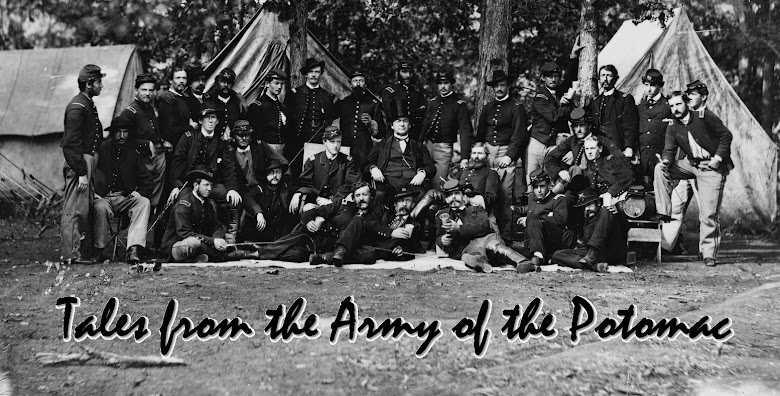The last two posts focused on the writings of Orlando
B. Willcox. As it is the 150th Anniversary of the Battle of Crater (in
which Willcox fought), I thought it best to give him another mention. Anyway,
this post focuses on Willcox’s quest to win promotion to the rank of major
general. It was a tough quest, rendered unnecessarily difficult due to an unwise
decision that Willcox had made years earlier.
It all began way, way, back in 1843, when nineteen-year-old Willcox traveled to Congressman Jacob Merritt Howard’s office to acquire a letter
of nomination for a cadetship to West Point. According to Willcox, Howard had
written him a substandard letter, one was intended to sink Willcox’s hopes in favor of
another candidate, one who aligned with the Whig Party. (Willcox was a
Democrat.) Certainly, Howard acted unfairly, but Willcox did a pretty heinous thing in reply. He opened the letter and falsified it, sending it along to get
his appointment. Years later, in 1856, Willcox furthered the rivalry with Howard by
publishing a novel, Shoepac Recollections,
in which he lampooned Howard as one of the book’s bumbling villains, O. H. P. Hustings. In short, Willcox had beaten Howard twice, once in the arena of promotion and once in the arena of literature.
(Here, you can see Senator Jacob Merritt Howard, Michigan's Radical Republican leader. "Put a knife in his hand," claimed Willcox, "and he will stab you in the back.")
(This the cover page to Shoepac Recollections, Willcox's novel. He published under a fake name, Walter March. Nevertheless, Howard figured out that Willcox was its author and that one of the idiotic villains was based on him.)
No doubt, Willcox expected he would never again have to beg for Howard’s help, but circumstances proved him wrong. Throughout the war,
Willcox tried to acquire a major generalship, and promotion frequently eluded him.
It did not take long to determine the cause. Senator Howard—who now sided with
the Radical Republicans—did his best to thwart Willcox’s confirmation. All of
this stemmed from the awkward system used by the Union army to promote its generals.
All officers who wanted a promotion to brigadier general or to major general
(either through brevet or substantive rank) had to apply to the War Department.
After reviewing each applicant’s record, the Secretary of War sent a list of names to the White House. There, President Lincoln selected
candidates from that list and “nominated” them for promotion. Usually, the
Senate confirmed the President’s list of nominees as a matter of course, but at times, the Republican Senators intentionally found
fault with a Lincoln’s Democratic nominees and employed legislative tricks to hold up
their confirmation.
Willcox believed this kind of devious political trickery happened to him. He complained
that Howard held a grudge, one that he had nursed ever since the publication of Shoepac Recollections. Later in life,
Willcox penned a short denunciation of the aging Senator. It did not mince words: “Such a man never forgives an
injury, fancied or real. Circumstances may conspire to make him pass over an
offence, or the pressure of his party may compel him to make it up for the
nonce. But after the settlement of a quarrel there is nothing of the pleasant
fervor of forgiveness & peace. If you have put the knife in his hand, he
will stab you in the back before the words of friendship have died upon his
lips.”
Willcox’s quest for a second star became more troubled after
the July 30, 1864, Battle of the Crater. Willcox’s 3rd Division, 9th Corps, had
played a supporting role in this disastrous assault. The Joint Committee on the
Conduct of the War had censured Willcox with a bad performance, and each time
his name went to the Senate there afterwards, Howard referred to report, using it as an excuse
to hold back his promotion. By 1865, as the war careened toward its conclusion,
Willcox believed he would miss his opportunity to receive a major generalship.
Out of options, he approached his boss, General Ulysses S. Grant, asking him to criticize publicly the
Joint Committee’s report. This tactic worked. In March 1865, one month short of the war’s conclusion in the East, Grant handed Willcox a brevet commission to major general,
telling him that Senate confirmation was imminent. No doubt, the news buoyed him. He had been a division commander for almost three years, and now he finally had recognition for his service. Jubilantly, Willcox wrote to his
wife, “You can imagine whether or not I rode home with a light heart after so
auspicious an interview & satisfactory results. The six miles to my
headquarters seemed scarcely three.”
Although Willcox never forgave Howard for his interference, he soberly took stock of his own mistakes. He wrote, “During the War of
the Rebellion I think I might have done some things better—& other things
worse, as in the rest of my life. My 1st mistake was incurring the
hostility of a Senator in Shoepac
Recollections. This prevented my confirmation as Maj. Gen’l from Antietam
& subsequent battles.”
Let this be a lesson to all: Insult your enemies at your own
peril. You never know when you’ll need their assistance later in life.
(Here, you can see Major General Orlando Willcox. It took a great deal of politicking to win the second star.)















